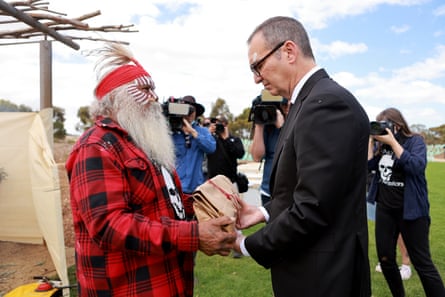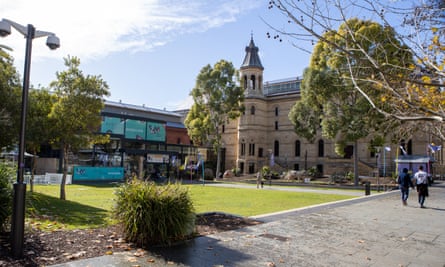For the past seven years the South Australian Museum has undergone a thawing of its long-strained relations with Indigenous peoples, thousands of whose ancestral human remains and cultural objects the institution has hoarded since the 1850s.
The museum has apologised to Indigenous Australians for the kleptocratic, inhuman practices by which it amassed a “collection’’ of Indigenous ancestral remains of about 4,600 people, patiently built previously nonexistent trust with South Australia’s Kaurna people, reburied hundreds of ancestors in Adelaide and repatriated remains to communities across Australia.
It has consequently been globally acknowledged for re-building broken relations with First Nations people, affording them increased custodianship of Indigenous collections and, not least, for bringing overdue dignity to the culturally incendiary issue of how museums treat ancestral remains.
But over the last few months a planned radical museum restructure has seriously undermined relations between the institution and Indigenous staff and stakeholders. Protests broke out in the notoriously civilised city while staff, Indigenous stakeholders, global scientific experts, politicians and wealthy donors embarked on an intense and uncharacteristic public and private lobbying effort to achieve government intervention. Their fear? That the global reputation of the museum was in danger of compromise, and, more importantly, its hard-won progress with First Nations people jeopardised.
And, so, on Thursday, South Australian Labor premier Peter Malinauskas intervened to put the planned changes on temporary hold.
A three-person panel will now conduct a review Malinauskas insists will “ensure the museum continues to deliver quality outcomes for all South Australians’’. It will report as early as June.

Until then, profound cultural and historical sensitivities involving Indigenous collections, Aboriginal staff and stakeholders hang in fine balance.
In the end, after a century and a half of often hostile relations between the museum and Indigenous communities – too often characterised with fear and cultural theft – change came swiftly to the conservative, old Adelaide institution. It was only after anthropologist John Carty arrived at the museum as head of humanities in 2016 that human remains (from the South Pacific Galleries) were removed from public display and a new progressive policy on repatriation of Indigenous ancestral remains (the first in three decades) was formulated.
The museum became a global leader on repatriation and reburial, and a culturally safer place for First Nations people. Indigenous experts began to work there in greater numbers and to collaborate on how to return more remains to country and to reconnect the largest collection of Australian First Nations cultural material in the world with the communities from which they were removed.
The impact of progress was profound; since 2019, the remains of more than 700 ancestors have been returned to the country of Aboriginal communities across the country. Comparatively, in the decade before SAM’s 2018 repatriation strategy, the museum returned 49 ancestors to one community.
It was this improved relationship with Indigenous communities and the ongoing repatriation work on – and reburial of – the ancestral remains that many critics feared was being potentially threatened by the proposed restructure by director David Gaimster, who took over the museum in mid-2023.
The now paused broad “reimagining” at SAM aimed to reduce and “reimagine’’ the roles of curatorial and research staff, and to make the institution more “sustainable, relevant, and accessible’’ for this century.
The proposed changes would abolish 27 research and collections roles and replace them with 22 mostly more junior positions, many involving greater multi-tasking. They have provoked public protest, including from the Public Service Association of South Australia, put enormous pressure on Malinauskas to intervene, and raised concern from some of the world’s leading scientists about potential irreparable damage to the reputation of an institution considered the primary natural science museum for Australia’s continental interior.
Globally celebrated mammalogist and former SAM director Tim Flannery has, for example, told InDaily the changes could spell “the death of the museum’’.
But it is the proposed abolition of the head of humanities and the Aboriginal heritage and repatriation roles held by Carty and Anna Russo respectively – as well as changes to the way Indigenous family research and secret/sacred collections would be managed under the proposed restructure – that have most angered and deeply concerned First Nations museum staff, South Australian elders and other Indigenous stakeholders.

Under the proposed restructure both Russo’s and Carty’s positions are replaced by a “repatriation curator’’.
Neither Carty nor Russo – nor any other Aboriginal and non-Indigenous staff – would comment to Guardian Australia on the changes, consistent with their employment obligations as South Australian public servants.
In an apparent message to senior museum management about the potential threat to reburial and repatriation, Kaurna/Ngarrindjeri elder Major ‘Moogy’ Sumner, told the ABC, “You’ve got people that’s been here from the start and you want to get rid of them? That’s dumb. You should be the one to go. Leave them people here. They’re more important than you will ever be.’’
The concerns of many are articulated in a recent letter from the South Australian State Aboriginal Heritage Committee to SAM board chair Kim Cheater, the state’s arts minister, Andrea Michaels, and Gaimster.
“SAM has held some 4,600 Aboriginal remains over the past 165 years. Many of these Old People found their way to SAM because of what are now recognised as abhorrent and dehumanising practices, with which SAM was in many cases complicit,’’ the committee wrote on 27 March.
after newsletter promotion
They said the cross-cultural work of repatriation, especially given how many ancestral remains are held by SAM, was very complex and demanded “significant patience, empathy, cultural knowledge, and interpersonal skills’’.
“The Committee has serious concerns that devolving Ms Russo’s repatriation role to a mid-level archaeologist will almost certainly hinder progress and damage the nascent trust that Ms Russo and her team have carefully built over recent years.’’
Committee members said that while the museum was entitled to reprioritise curation over research, the institution’s collection of First Nations human remains “can never be displayed in a curated event at SAM’’. They urged the museum to maintain the current level of resources for repatriation of ancestral remains.
There is growing concern among Aboriginal and non-Indigenous stakeholders that having chosen a difficult path of decolonisation the proposed changes now threaten a “re-colonisation” of the museum, considered by some to be the most traditionally-conservative British-style collecting institution in Australia.
In recent correspondence to the state Minister for Aboriginal Affairs Kyam Maher, eight current museum staff wrote, “Positioning ancestral remains in the restructure as a collection to be curated, returns the Ancestors to the equal of rocks and boomerangs.

“‘Restoring dignity’ is a term often used by Elders when reburying their ancestors. Rather than restoring dignity the restructure, in this way, represents a deeply colonial backward step.’’
Arrernte elder and former chair of SAM’s Aboriginal Advisory Committee David Rathman told Guardian Australia the proposed changes were “destructive’’ and he had conveyed his concerns about the future of the Aboriginal projects to Gaimster.
In the “hostile” post-voice referendum environment, says Rathman, “this trust that is there [at the museum] needs to be preserved and fostered and developed because Aboriginal people have always built their trust on the respect and continuity of contact”.
In the weeks leading up to the state government Anzac Day intervention, opposition to the restructure bubbled over; public and private letters from staff, the museum world, politicians and beyond put mounting pressure on the government and museum.
On 11 April Aboriginal staff wrote to Gaimster with concerns that the restructure was at odds with the museum’s most recent Reconciliation Action Plan, that Indigenous stakeholders had not been consulted, and that the restructure “devalues the work of staff members employed to carry out Aboriginal related business”. For one thing, the restructure overlooked the cultural considerations relating to the Secret Sacred collections that requires men and women to manage the roles separately.
“How the Museum has handled ancestral remains prior to the appointment of an Aboriginal Heritage and Repatriation Manager is leading to strong concerns that through its current actions, the Museum could find itself at odds again with Aboriginal stakeholders far into the future,” they wrote.
In a statement to Guardian Australia Gaimster said “the museum welcomes” the premier’s intervention “and we look forward to the Review recommendations’’.
He said the museum “recognises and respects the expertise” of staff and “there are no plans to devolve or change the nature of the repatriation role”.
“We are committed to maintaining our program of repatriation and the continued management of our significant First Nations Collections. We wrote to the [South Australian Heritage Council] earlier this month assuring them that the Museum would not be reducing its commitment or services for any of our First Nations communities and stakeholders,” he said.
“We have actively consulted with staff and the Chair of the Museum’s Aboriginal Partnership Committee facilitated a dedicated meeting with our First Nations staff and has provided us with valuable feedback and suggestions. No decisions have been or will be made without consideration of that feedback.”
Meanwhile as the museum and its stakeholders await the review findings, in a locked and darkened room on the outskirts of Adelaide, the remains of 3,500-plus ancestors remain packed in cardboard boxes on shelves awaiting return to country and reburial. For now the hope that this will happen any time soon is fast diminishing.
